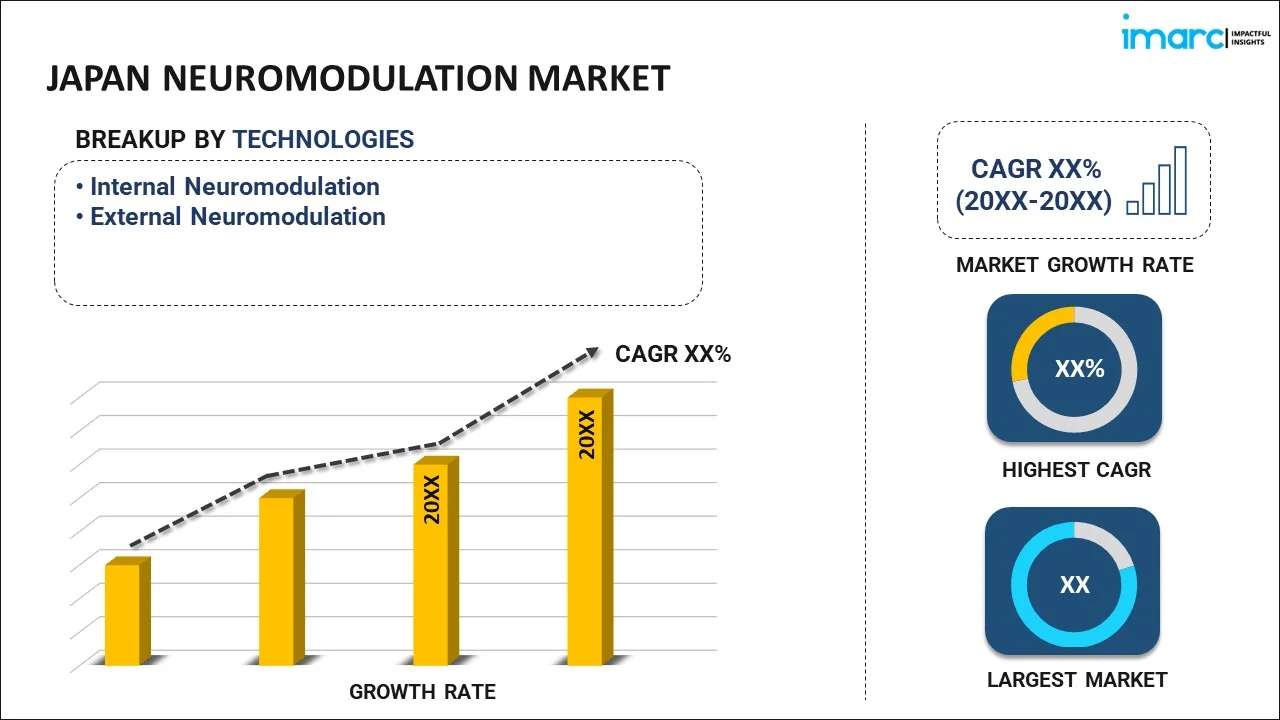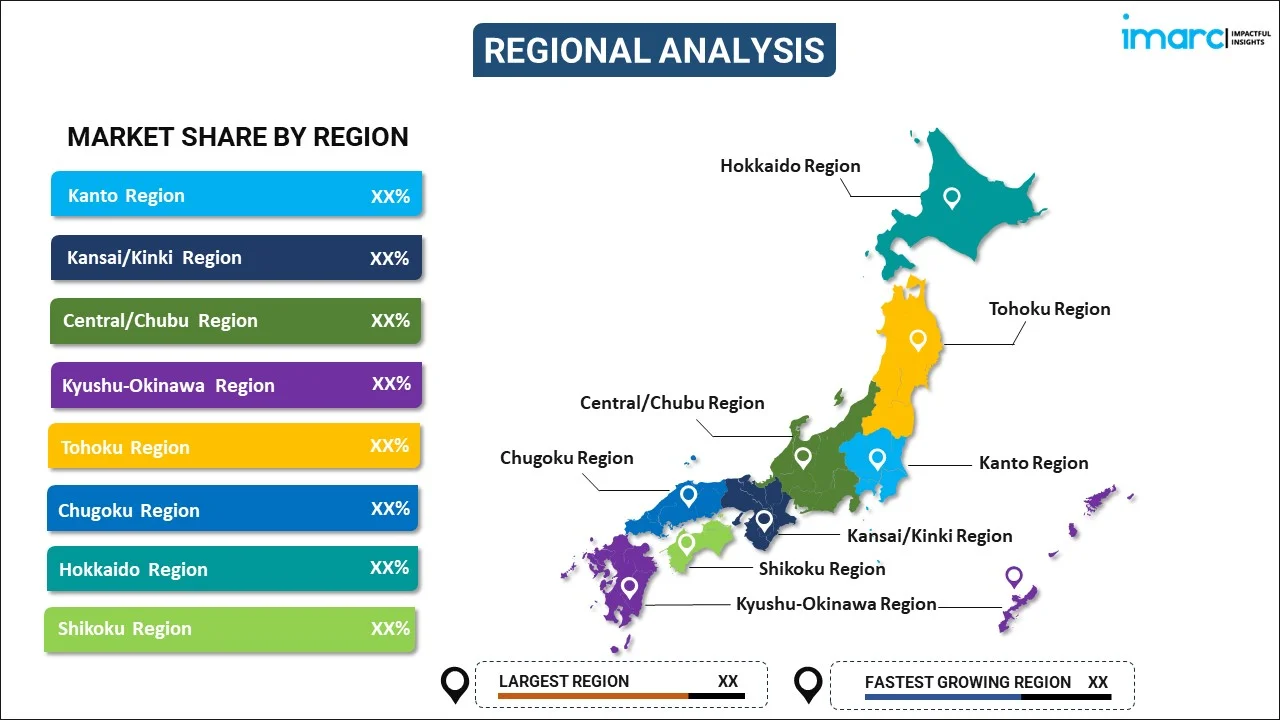
Japan Neuromodulation Market Report by Technology (Internal Neuromodulation, External Neuromodulation), Biomaterial (Metallic Biomaterials, Polymeric Biomaterials, Ceramic Biomaterials), Application (Parkinson's Disease, Epilepsy, Depression, Dystonia, Pain Management, and Others), and Region 2025-2033
Market Overview:
Japan neuromodulation market size reached USD 349.2 Million in 2024. Looking forward, IMARC Group expects the market to reach USD 1,029.8 Million by 2033, exhibiting a growth rate (CAGR) of 12.8% during 2025-2033. The rising geriatric population in Japan, recent technological advancements, increasing healthcare expenditure, heightened awareness about the benefits of neuromodulation, strong presence of key market players, and introduction of favorable reimbursement policies represent some of the key factors driving the market.
|
Report Attribute
|
Key Statistics
|
|---|---|
|
Base Year
|
2024 |
|
Forecast Years
|
2025-2033 |
|
Historical Years
|
2019-2024
|
| Market Size in 2024 | USD 349.2 Million |
| Market Forecast in 2033 | USD 1,029.8 Million |
| Market Growth Rate (2025-2033) | 12.8% |
Neuromodulation refers to a technology involving the modification of nerve activity by delivering pharmaceutical or electrical agents to targeted areas of the nervous system. It encompasses a wide range of types, including spinal cord stimulation, deep brain stimulation, sacral nerve stimulation, and peripheral nerve stimulation. Neuromodulation is comprised of several components, such as a pulse generator, electrodes, and a handheld device for programming. It offers multiple features, including minimally invasive procedures, customizable treatment settings, and real-time feedback mechanisms. Neuromodulation is widely used for treating chronic pain, epilepsy, movement disorders, psychiatric conditions, migraines, and gastrointestinal issues. It offers targeted therapy, reduced side effects as compared to systemic drug administration, reversibility, and the potential for remote patient monitoring. Additionally, neuromodulation provides several advantages, such as enhanced patient compliance, better quality of life, cost-effectiveness in the long run, and the opportunity for real-time adjustments to treatment settings.
Japan Neuromodulation Market Trends:
The rising geriatric population in Japan, contributing to the escalating incidences of neurological and chronic disorders, is propelling the market growth. Additionally, recent technological advancements, such as the advent of wireless neuromodulation, that are expanding the technique’s applications are driving the market growth. Besides this, the increasing healthcare spending and the prioritization of neurological research, fostering a conducive environment for market expansion, is acting as another growth-inducing factor. Furthermore, the heightened awareness about the benefits of neuromodulation, which is facilitating faster adoption rates, is catalyzing the market growth. In addition to this, the strong presence of key market players and frequent product launches in Japan is stimulating the market growth. Apart from this, the introduction of favorable reimbursement policies by the government healthcare system for neuromodulation procedures is bolstering the market growth. Moreover, the growing evidence of the efficacy of neuromodulation through clinical trials, lending further credence to the technology, is positively influencing the market growth. Along with this, the widespread demand for minimally invasive procedures, boosting neuromodulation applications, is supporting the market growth. In line with this, the escalating number of skilled healthcare professionals in the field of neuromodulation is driving the market growth. Furthermore, the integration of artificial intelligence (AI) for real-time adjustments and monitoring is creating a positive outlook for the market growth. In addition, the rising patient compliance and satisfaction rates with neuromodulation, encouraging more referrals, is accelerating the market growth. Besides this, the increasing strategic collaborations and acquisitions among key players to expand further research and leverage shared expertise are strengthening the market growth. Additionally, the growing public and private investment in research and development (R&D) activities is fueling the market growth.
Japan Neuromodulation Market Segmentation:
IMARC Group provides an analysis of the key trends in each segment of the market, along with forecasts at the country level for 2025-2033. Our report has categorized the market based on technology, biomaterial, and application.
Technology Insights:

- Internal Neuromodulation
- Spinal Cord Stimulation (SCS)
- Deep Brain Stimulation (DBS)
- Vagus Nerve Stimulation (VNS)
- Sacral Nerve Stimulation (SNS)
- Gastric Electrical Stimulation (GES)
- External Neuromodulation
- Transcutaneous Electrical Nerve Stimulation (TENS)
- Transcranial Magnetic Stimulation (TMS)
- Others
The report has provided a detailed breakup and analysis of the market based on the technology. This includes internal neuromodulation (spinal cord stimulation (SCS), deep brain stimulation (DBS), vagus nerve stimulation (VNS), sacral nerve stimulation (SNS), and gastric electrical stimulation (GES)) and external neuromodulation (transcutaneous electrical nerve stimulation (TENS), transcranial magnetic stimulation (TMS), and others).
Biomaterial Insights:
- Metallic Biomaterials
- Polymeric Biomaterials
- Ceramic Biomaterials
A detailed breakup and analysis of the market based on the biomaterial have also been provided in the report. This includes metallic biomaterials, polymeric biomaterials, and ceramic biomaterials.
Application Insights:
- Parkinson's Disease
- Epilepsy
- Depression
- Dystonia
- Pain Management
- Others
The report has provided a detailed breakup and analysis of the market based on the application. This includes parkinson's disease, epilepsy, depression, dystonia, pain management, and others.
Regional Insights:

- Kanto Region
- Kansai/Kinki Region
- Central/ Chubu Region
- Kyushu-Okinawa Region
- Tohoku Region
- Chugoku Region
- Hokkaido Region
- Shikoku Region
The report has also provided a comprehensive analysis of all the major regional markets, which include Kanto Region, Kansai/Kinki Region, Central/ Chubu Region, Kyushu-Okinawa Region, Tohoku Region, Chugoku Region, Hokkaido Region, and Shikoku Region.
Competitive Landscape:
The market research report has also provided a comprehensive analysis of the competitive landscape in the market. Competitive analysis such as market structure, key player positioning, top winning strategies, competitive dashboard, and company evaluation quadrant has been covered in the report. Also, detailed profiles of all major companies have been provided.
Japan Neuromodulation Market Report Coverage:
| Report Features | Details |
|---|---|
| Base Year of the Analysis | 2024 |
| Historical Period | 2019-2024 |
| Forecast Period | 2025-2033 |
| Units | Million USD |
| Scope of the Report | Exploration of Historical Trends and Market Outlook, Industry Catalysts and Challenges, Segment-Wise Historical and Future Market Assessment:
|
| Technologies Covered |
|
| Biomaterials Covered | Metallic Biomaterials, Polymeric Biomaterials, Ceramic Biomaterials |
| Applications Covered | Parkinson's Disease, Epilepsy, Depression, Dystonia, Pain Management, Others |
| Regions Covered | Kanto Region, Kansai/Kinki Region, Central/ Chubu Region, Kyushu-Okinawa Region, Tohoku Region, Chugoku Region, Hokkaido Region, Shikoku Region |
| Customization Scope | 10% Free Customization |
| Post-Sale Analyst Support | 10-12 Weeks |
| Delivery Format | PDF and Excel through Email (We can also provide the editable version of the report in PPT/Word format on special request) |
Key Questions Answered in This Report:
- How has the Japan neuromodulation market performed so far and how will it perform in the coming years?
- What has been the impact of COVID-19 on the Japan neuromodulation market?
- What is the breakup of the Japan neuromodulation market on the basis of technology?
- What is the breakup of the Japan neuromodulation market on the basis of biomaterial?
- What is the breakup of the Japan neuromodulation market on the basis of application?
- What are the various stages in the value chain of the Japan neuromodulation market?
- What are the key driving factors and challenges in the Japan neuromodulation?
- What is the structure of the Japan neuromodulation market and who are the key players?
- What is the degree of competition in the Japan neuromodulation market?
Key Benefits for Stakeholders:
- IMARC’s industry report offers a comprehensive quantitative analysis of various market segments, historical and current market trends, market forecasts, and dynamics of the Japan neuromodulation market from 2019-2033.
- The research report provides the latest information on the market drivers, challenges, and opportunities in the Japan neuromodulation market.
- Porter's five forces analysis assist stakeholders in assessing the impact of new entrants, competitive rivalry, supplier power, buyer power, and the threat of substitution. It helps stakeholders to analyze the level of competition within the Japan neuromodulation industry and its attractiveness.
- Competitive landscape allows stakeholders to understand their competitive environment and provides an insight into the current positions of key players in the market.
Need more help?
- Speak to our experienced analysts for insights on the current market scenarios.
- Include additional segments and countries to customize the report as per your requirement.
- Gain an unparalleled competitive advantage in your domain by understanding how to utilize the report and positively impacting your operations and revenue.
- For further assistance, please connect with our analysts.
 Inquire Before Buying
Inquire Before Buying
 Speak to an Analyst
Speak to an Analyst
 Request Brochure
Request Brochure
 Request Customization
Request Customization




.webp)




.webp)












